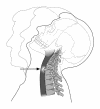Esophageal perforation in closed neck trauma
- PMID: 18031626
- PMCID: PMC2386200
Esophageal perforation in closed neck trauma
Figures
References
-
- Asensio JA, Berne J, Demetriades D, et al. Penetrating esophageal injuries: time interval of safety for preoperative evaluation — How long is safe? J Trauma 1997;43:319-24. - PubMed
-
- Kollmar O, Lindemann W, Richter S, et al. Boerhaave's syndrome: primary repair vs. esophageal resection: case reports and meta-analysis of the literature. J Gastrointest Surg 2003;7:726-34. - PubMed
-
- Stringer WL, Kelly DL, Johnston FR, et al. Hyperextension injury of the cervical spine with esophageal perforation. J Neurosurg 1980;53:541-3. - PubMed
-
- Stiell IG, Wells GA, Vandemheen KL, et al. The Canadian C-spine rule for radiography in alert and stable trauma patients. JAMA 2001;286:1841-8. - PubMed
Publication types
MeSH terms
LinkOut - more resources
Full Text Sources
Medical


